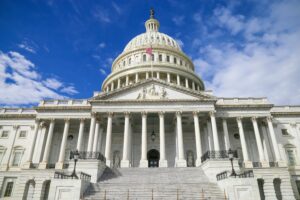Capitol Compass: August 2024 Edition
- On August 23, Federal Reserve Chair Jerome Powell suggested that the Fed is close to achieving its 2% inflation target. Powell further noted that pandemic-related economic distortions are diminishing, and that the U.S. is on a sustainable path to the inflation target.
- Powell also indicated that the time is right for adjusting policy, signaling the potential for rate cuts as early as September. The Fed’s benchmark rate is currently 5.25% – 5.50%, but a new benchmark rate has not yet been announced. Nevertheless, markets are anticipating significant rate cuts by year-end.
- Powell has received criticism for the Fed’s rate policies, with critics pointing out that high interest rates slow down the overall economy, diminishing business development and job growth. Recently, the Bureau of Labor Statistics discovered a technical error which revealed the U.S. economy added 818,000 fewer jobs between April 2023 and March 2024 than previously reported.
- However, others have praised the Fed’s policies on the grounds that they helped ease inflation and staved off a recession. There are still many debates about the possibility of a recession, but the Fed plans to conduct a formal review of its economic strategy and base future actions on incoming data.
Surging Political Campaigns
- The Republican National Convention and Democratic National Convention recently concluded, invigorating their respective party candidates and supporters. Vice President Kamala Harris and Governor Tim Walz (D-MN) have positive momentum among Democratic voters. Meanwhile, former President Donald Trump and Sen. JD Vance (R-OH) have also built up some momentum among Republican voters.
- Media attention has been geared towards Harris’s and Trump’s running mates, Walz and Vance. Walz has left a strong impression on the public, as his favorability among voters has increased. In contrast, Sen. JD Vance has been struggling in the polls since being selected as Trump’s running mate. FiveThirtyEight’s polling averages for Vance show 44.1% of Americans have an unfavorable opinion of the Senator, while 34.3% have an favorable opinion of him. In contrast, Walz’s polling averages show that 39.2% of Americans view him favorability compared to 35.1% that view him unfavorably.
- Nevertheless, voters’ attention has historically been more focused on the presidential candidate rather than the vice-presidential candidate. While Harris leads nationally, battleground state polls remain tight.
- Furthermore, convention boosts can be short-lived, as Trump had received a noticeable boost in national polls after the RNC. Unexpected developments, such as economic changes or international incidents, could impact the election in November.
Tax Policy
- A major, looming policy issue for the next administration is tax policy. Many provisions in the Tax Cuts and Jobs Act of 2017, a significant legacy of the Trump Administration and Republican-controlled Congress, are set to expire after 2025. This will present a major opportunity for the next administration, and Congress, to set future government revenue and spending.
- For example, the marginal tax rates for individuals will revert to pre-2017 levels, including maximum rate of 39.6%, from 37%. Furthermore, standard deduction amounts will be lower by almost half and adjusted for inflation. The $10,000 cap on state and local tax deductions will also expire. The Child Tax Credit will also drop from $2,000 to $1,000 per child. For businesses, immediate deduction for capital investments will phase out after 2026, and pass-through businesses will no longer be able to deduct up to 20% of qualified income.
- Looking at the platforms of the presidential candidates gives us some insight into what taxpayers and businesses might expect under their administration. Harris favors expanding the child tax credit to $3,600 from $2,000 per dependent and offer a $6,000 credit for newborns, expand the Earned Income Tax Credit for workers without children, and extend enhanced premium tax credits under the Affordable Care Act.
- Trump is supporting a permanent extension of the individual income tax cuts from the Republicans’ 2017 tax bill. Some advisers have pushed to keep the cap on SALT deductions, and his running mate Vance floated expanding the child tax credit to $5,000.
- Both Harris and Trump have stated that they would eliminate or exempt taxed on tip wages, but Trump has gone further and supported eliminating taxes on Social Security payments. However, the two candidates have proposed different corporate tax rates. Harris supports a 28% corporate tax rate, and Trump favors a 15% corporate tax rate. Trump’s proposal is a reduction from the 21% rate set by the 2017 tax bill. While Harris’s proposal would roll back the 2017 cut, it does not bring taxes on corporate income to the pre-2017 level of 35%.
- We can expect more policy proposals from both campaigns in the coming weeks. Top issues for voters and interest groups include immigration, abortion, energy and climate, labor and wage issues, and more.


